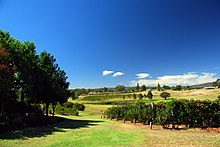Swan Valley
Swan Valley is a wine-growing region on both sides of the Swan River northeast of the western Australian capital Perth .
location
The wine-growing region extends from Guildford (approx. 20 km northeast of Perth) another approx. 20 km upstream to south of the Bells Rapid picnic area; to the east it borders the Darling Scarp range of hills and from the west the two brooks Ellen Brook and Jane Brook flow into the Swan River. The wine-growing area covers approx. 300 hectares on the territory of the districts Caversham, West Swan, Middle Swan, Herne Hill, Henley Brook, Millendon, Baskerville, Belhus, Upper Swan, Brigadoon and Whiteman, which together form the Local Government Area of the City of Swan are subject to.
The vineyards do not come close to the river, which is still navigable with small excursion boats and which is bordered by dense acacia and banksia bushes, but rather extend away from the watercourse in the gently rolling landscape.
history
The land on the Swan River was discovered in 1827 by Captain James Stirling , who two years later founded the Swan River Colony and established three settlements ( Fremantle , Perth and Guildford) in it. The river itself, with its eponymous black swans , was first sailed by the Dutch explorer Willem de Vlamingh in 1697; However, this only came as far as the Matagarup Watt, where Heirisson Island is today, at the height of today's city center of Perth. A French expedition under Nicholas Baudin sailed further upstream in 1801 but did not take possession of the land.
On the lower reaches of the Swan River south of Guildford, for example, vines were grown in Dalkeith.
In 1836 at the latest - presumably as early as 1830 - the first vines were planted on the upper reaches of the river (in the so-called Swan Location II ) under Stirling's expedition leader Revett Henry Blend, to whom the later first governor of Western Australia had given this land in recognition of his achievements. The core area around the area of the Houghton estate was the nucleus of this cultivation area, which is well known and popular among Australian wine connoisseurs of the 21st century. For almost 150 years, the Swan Valley was the only wine-growing region in Western Australia ; other growing areas in the extreme south of this state (e.g. on the Margaret River ) were only planted with vines in the second half of the 20th century, but in the 21st century they account for the greater proportion of westerns due to the easier growing conditions in the cooler climate zone Australias wine production out.
Viticulture
The Swan Valley has an average temperature of 24 ° C and a low humidity of 45%. These are good conditions for the predominantly white grape varieties to thrive; however, artificial irrigation is required in the hot, dry summer months. Chenin Blanc is the most commonly grown, followed by Verdelho and Chardonnay . Shiraz and Merlot dominate the red grape varieties. Lesser-known grapes such as Dolcetto , Pedro Ximénez and Navera are also being experimented with .
The largest wine producers in the Swan Valley are Houghton and Sandalford , who are active in exports around the world. There are also around 80 smaller family-owned wineries, which often maintain a restaurant in addition to the point of sale and / or provide overnight accommodation.
tourism
Most overseas tourists explore the Swan Valley as part of organized boat trips on the Swan River (so-called Wine Cruises ), which can be booked daily from Perth or Fremantle; Provided buses drive the large wine production facilities for group tours.
The smaller wineries are preferred by individual travelers; many of them can be viewed on request.
In addition to the wineries, there are also around 20 breweries in the Swan Valley that are visited by tourists. Numerous artists have set up galleries. Visitors staying for several days can spot koalas , horse riding, and golf at Swan Valley Wildlife Park .
map
- Swan Valley. Guide and Maps, ed. from the Swan Valley and Eastern Region Visitor Center, May 2005
Individual evidence
- ^ Nedlands Road and Street Listing - Origin of Names. City of Nedlands, May 31, 2012, accessed January 6, 2019 .
- ↑ Armstrong's legacy celebrated in the official naming ceremony of pavilion. City of Nedlands, 2017, accessed on January 6, 2019 (English): "He was the first person to grow grapes and figs for commercial purposes and farmed the best goat run in the Colony."
- ↑ JHM Honniball: The Tuckeys of Mandurah. (PDF) In: Journal and Proceedings. The Western Australian Historical Society, 1961, accessed January 6, 2019 .
